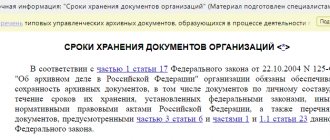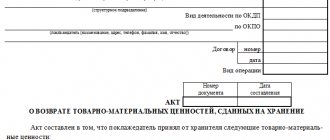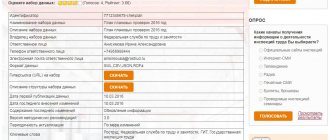Receipt of materials
In accordance with paragraph 2 of section. 2 guidelines for accounting of inventories, approved by Order of the Ministry of Finance dated December 28, 2001 No. 119n, the concept of “materials” includes a wide range of enterprise inventories with a useful life of less than a year. Materials include:
- raw materials necessary for the production of semi-finished or finished products;
- auxiliary materials that are not included in the finished product, but are used to ensure the operability of the equipment, as well as any technological needs;
- fuels and lubricants;
- spare parts;
- container;
- purchased semi-finished products;
- waste production;
- others.
In an organization that has warehouses, the manager’s order approves a list of materially responsible persons (MRPs) responsible for the safety and maintenance of warehouse records of materials for each warehouse.
Inventory and materials received from suppliers have a set of shipping documentation, represented by an invoice (form TORG-12, M-15 or another accepted by the supplier), an invoice, a waybill, and a specification. Of these, the invoice serves as the basis for capitalization. In the absence of shipping documents, materials can also be capitalized.
Read about the rules for such posting in the article “How to post goods without accompanying documents.”
Upon acceptance, materials must be checked for compliance of the actual quantity, quality and assortment with the data stated in the supplier’s accompanying documents.
If no discrepancies were identified during the verification process, the MOL issues a receipt order in Form M-4. It is allowed to put a stamp on the supplier's documents instead of receipt orders. The stamp must reflect all M-4 details.
If, after the inspection, discrepancies are still identified, it is necessary to issue a statement of discrepancies in the TORG-2 form.
For the form and sample of filling out this form, see the material “Unified form TORG-2 - form and sample” .
Another way of receiving materials is their purchase by accountable persons at retail outlets. In this case, the primary source is invoices or sales receipts attached to the expense report.
ConsultantPlus draws your attention to the fact that starting from 2021, materials must be taken into account strictly in accordance with the new Federal Accounting Standards 5/2019 “Inventories”. The new rules were explained in detail by legal experts. To see the recommendations, get trial access to K+ for free and go to the ready-made solution.
Document retention periods
The storage period is calculated from the first day of the first month of the year following the year in which the document was executed. For example, a case was closed in office work or a personal matter was completed in accordance with the dismissal order. If the document was drawn up in 2017, then the start date of its storage is calculated from January 1, 2021. However, there are two exceptions to this rule:
- Registers for deducting VAT (purchase book, sales book, invoice journal). The period from which their storage is determined is determined by the date of the last entry made in the register.
- Documents confirming the original cost of depreciable property. The shelf life is determined from the moment depreciation ceases.
The deadline for storing documents containing personal data of company employees is 75 years from the date of their creation. Such documents include labor and service agreements, GPC agreements, personal cards of employees, unclaimed personal documents (for example, work books, certificates, diplomas, certificates and certificates).
Important! In accordance with Law No. 43-FZ, the document storage period of 75 years applies to documents created before 2003. If the document was created after 2003, then the storage period is already 50 years from the date of their creation.
Orders on disciplinary sanctions, annual leave, educational leave, on duty and short-term documents are stored for at least 5 years.
Documents on the calculation and payment of insurance premiums to extra-budgetary funds are kept by the policyholder for 6 years. After the specified retention period expires, the documents must be destroyed.
Organization of warehouse accounting of materials
Accounting for inventory items in the accounting department and in the warehouse can be carried out using the quantitative-total and balance method.
When using the first option, both in warehouses and in accounting, inventory records are kept by quantity and amount simultaneously.
If the accounting policy has approved the balance method, then in the warehouse inventory items are taken into account by quantity, and in the accounting department - in total terms.
Keeping inventory records of materials is possible in two ways: batch and grade.
- Batch method.
In this case, each batch of inventory items is stored separately. A batch is a homogeneous material received according to one document. For each batch, MOL issues a batch card in two copies: 1st - for the warehouse, 2nd - for the accounting department. The form is approved by the company independently, depending on the type of inventory.
In the incoming part of the document, data is entered according to the primary document received from the supplier, in the outgoing part - data on the fact of write-off of materials. After the complete release of the entire batch of goods and materials, the batch card is closed, the MOL draws up an act of consumption of goods and materials and transfers the entire package of documents to the accounting department for verification.
- Varietal method.
Warehouse accounting of materials in this way is carried out by names and grades of goods and materials, regardless of the date of receipt and price. For each name of material, a materials accounting card (form M-17) is created, which is registered in a special accounting register. This card is maintained throughout the year.
When maintaining warehouse records using the sort method, warehouse space is used economically and material balances are easily managed. However, it is not possible to track the price of receipt of goods and materials, and the material is written off at the average cost using the FIFO method or at the unit price (clause 73 of order No. 119n).
Read more about the M-17 form in the article “Material Warehouse Card - Form and Sample.”
Standards for storing accounting documents
The procedure by which the company maintains accounting records and stores accounting documents is approved by the manager. This follows from Law No. 402-FZ “On Accounting” (Article 7). Based on the general rules, processed primary documents related to one accounting register are filed in a separate folder in chronological order. For example, cash or bank documents. The storage of documents that fall into the accounting department, are created and accumulated there, and have various purposes occurs in accordance with Article 29 of this law. The procedure is organized in accordance with the following standards:
- Primary documents, accounting registers, financial statements, as well as auditors' opinions on them are stored in the company for the period established by the rules of the state archive, but not less than 5 years after the end of the reporting period.
- Accounting policies, economic standards and other documents on the organization and maintenance of accounting must be stored for at least 5 years after the end of the year in which the documents were last used in the preparation of accounting or tax reporting. The same requirements are established for tools that provide reproduction of documents in electronic form, as well as verification of electronic signatures for authenticity.
- Companies are required to provide conditions for the safe storage of accounting documents, as well as protect them from changes.
- In the event of a change in the head of the company, it is necessary to ensure the transfer of accounting documents. The procedure by which the transfer occurs is determined by the company independently.
Intra-warehouse movement of goods and materials
Some accountants or merchandisers may ask, “What is movement?” In the course of business activities, an enterprise needs to move materials between warehouses or structural divisions. The primary document in this case is the demand invoice (form M-11). It is issued by the MOL of the sending party in 2 copies: the 1st remains with the transferring party and serves as the basis for writing off materials from the register, the 2nd is transferred to the MOL of the receiving party and is the basis for accepting the goods and materials for registration.
For information on filling out a demand invoice, read the material “Procedure for filling out form M-11 demand invoice.”
What documents must be kept?
The laws on joint stock companies and LLCs contain a list of documents that must be kept (Article 89 of the Law of December 26, 1995 No. 208-FZ, Article 50 of the Law of February 8, 1998 No. 14-FZ). These include, in particular, primary documents, accounting registers and financial statements.
The terms and procedure for storing LLC documents must be enshrined in the charter (Clause 2, Article 12 of Law No. 14-FZ of February 8, 1998).
But the procedure for storing documents in joint-stock companies has already been determined by Resolution of the Federal Commission for the Securities Market of Russia dated July 16, 2003 No. 03-33/ps, which is applied taking into account the order of the Ministry of Culture of Russia dated August 25, 2010 No. 558.
In any case, it would not hurt to write down the storage rules in the organization’s internal documents, for example, in the Archive Regulations.
Inventory
In order to identify the actual availability of inventory items listed in accounting records, the organization conducts a warehouse inventory. It can be carried out as necessary by order of the manager, and also without fail in the following cases (clause 22 of order No. 119n):
- when selling materials;
- when changing MOL;
- when identifying cases of damage or theft of inventory items;
- in the 4th quarter before the preparation of annual accounting reports;
- in case of emergency (fire, flood, etc.);
- upon liquidation of the company.
The frequency of the audit may also be reflected in the accounting policy of the enterprise.
The audit procedure is regulated by methodological guidelines for inventory of property, approved by Order of the Ministry of Finance of the Russian Federation dated June 13, 1995 No. 49.
First of all, the enterprise issues an order to conduct an inventory indicating the persons - members of the commission (at least 3 people) and is endorsed by the manager (INV-22 form). Such a commission has the right to conduct an audit only in full force in the presence of the MOL. Before carrying out the inspection, the MOL writes a receipt in any form stating that all inventory items have been taken into account and the documents have been transferred to the accounting department.
Inspectors check the actual availability of materials with a list called the inventory list (INV-3 form).
Read about the inventory list used when checking the availability of materials in the article “Unified form INV-3 - form and sample” .
Such a document contains a column with data on the amount of materials accounted for in accounting, and an empty column in which inspectors can reflect the actual presence of inventory items. After a complete recalculation of values, the commission signs this statement. The MOL records on the last page that the inspection was carried out in its presence and that there are no complaints against the commission.
If, as a result, discrepancies are identified between the accounting and actual quantities, a document is drawn up - a matching statement, in which all such discrepancies are recorded (form INV-18).
Read about the specifics of filling out this statement in the material “Unified Form INV-18 - Form and Sample” .
If a surplus is identified, it must be taken into account. It is considered the income of the enterprise and is recorded in the credit of the 91st account.
If misgrading of inventory items is detected, the result can be offset against each other. Such an offset is possible only for 1 MOL for 1 audited period and only for similar types of products in equal quantities (clause 32 of Order No. 119n).
If a shortage is identified, first of all it is necessary to find out whether there was a natural loss (for example, shrinkage, shrinkage). The shortfall within the limit is considered an expense of the enterprise and is written off as a debit to the 26th (44th) account; the excess limit and the actual shortfall must be reimbursed by the MOL. To reflect the identified discrepancies, the INV-26 form can be used.
For the procedure for filling out this form, see the article “Unified Form No. INV-26 - Form and Sample” .
ConsultantPlus experts spoke in detail about the nuances of conducting an inventory. Study the material by getting trial access to the K+ legal reference system for free.
Features of organizing the storage of technical documentation in a modern organization
Each organization, in the course of its activities, creates management documents (personnel records documents, accounting documents, organizational and administrative documentation, etc.). The rules for working with such documents are regulated at the legislative and normative-methodological level; many articles have been written on organizing work with them. But what to do if specific types of documents—scientific and technical—are accumulated in the organization’s archives?
This article draws attention to the organization of work with scientific and technical documents generated in the technical departments and services of manufacturing enterprises. The article will be useful both to specialists of technical departments for the formation of files and the organization of their current storage, and to a greater extent for archive managers, archivists and other specialists of organizations who have an archive at their disposal, to which, in addition to management documents, scientific and technical documents are also submitted.
To begin with, let’s define what we mean by the term scientific and technical documentation. Scientific and technical documentation is the basis of any production process; it contains the information necessary in the process of carrying out any work, as well as during the subsequent operation of the constructed facilities. Scientific and technical documents are divided into subtypes that have their own specifics. According to the “Rules for the operation of scientific and technical documentation services (departments, bureaus, archives) of research, design, engineering, technological organizations and enterprises,” scientific and technical documentation is divided into the following main groups:
- research documentation;
- design and planning documentation in the field of capital construction;
- design documentation;
- technological documentation;
- documentation on invention and rationalization;
- special documentation. [1].
Due to the fact that each group of scientific and technical documentation has a certain legal regulation and includes various types of documents, in this article we will focus on design documentation for construction. It is created to carry out the design of buildings, structures, roads, bridges, etc. Design documentation is developed not only in the form of text, but also in the form of drawings.
In organizations, the work of creating and processing technical documents is assigned to specialized production departments, services, bureaus, laboratories, etc. Specialists from such departments are engaged in the development, coordination, and approval of technical documentation. There are no special problems at this stage of work. Difficulties arise when large volumes of documentation created are no longer necessary for daily use, and due to the large number of volumes and copies of technical documentation, they must be transferred to the archive.
Despite the fact that the Basic Rules for the Operation of the Organization's Archives stated that, depending on the composition of the documentation to be stored in the archive, the following can be created: an archive of management documentation; scientific and technical archive; audiovisual archive; archive of documentation on electronic media; most often in organizations, all documentation is stored in one archive. [2] No such recommendations were found in the new Rules. [3]
Let's try to figure out what are the differences in storing management and technical documentation. Firstly, technical documentation can be created by employees of the enterprise itself, or ordered from design institutes. If documents are prepared by a design institute, the fact of transfer of documents is reflected in the invoice or in the acceptance certificate.
Secondly, unlike management documentation, technical documentation is created in several copies (for the customer, contractor, developer, etc.), the content of the ordered volumes is regulated by law. For example, project documentation includes the following sections: Explanatory note, Scheme of planning organization of a land plot, Architectural solutions, Structural and space-planning solutions, Information about engineering equipment, about networks of engineering support, List of engineering and technical measures, content of technological decisions, Project for organizing construction, Project for organizing work on demolition or dismantling of capital construction projects, List of measures for environmental protection, Measures to ensure fire safety, Measures to ensure access for people with disabilities, etc. [4]
In addition, the format of the created technical documents is not always the A4 format familiar to management documents, since work schedules and drawings can be created in A1 format or smaller. When preparing such cases for transfer to archival storage, large format sheets must be unfolded and numbered in the upper right corner, and then hemmed at one edge.
The following distinctive features of technical documentation are special features of systematization of documents into files. For management documents, the following principles are distinguished: nominal attribute - by the name of types of documents ( orders, instructions, instructions, acts, certificates, etc.), subject-matter attribute - according to the content of documents (documents on competitive procedures), author's attribute involves grouping into files of documents of one author, grouping of documents for a certain period is carried out on a chronological basis, etc. Technical documentation is formed into files for construction projects. Cases have a certain numbering: the title of the volume contains the name of the section or subsection, in addition, in each volume the contents of the project are placed on the first pages, which greatly facilitates the search for the required volume.
It should also be noted that among the technical documents transferred to the archive, there may be documents containing confidential information. Most often, it is in such documents of the organization that work technologies and know-how of the enterprise are contained. Therefore, the official responsible for the technical archive needs to be aware of the availability of such documents. This can be a whole project or its individual sections. The responsible employee must ensure the secure storage of such documents, limit free access to them, and also maintain separate records of confidential documents. To ensure the safety of restricted access documents, the archive must have locked cabinets or safes.
It is not an easy task to determine the retention period for technical documents. Despite the fact that the storage periods for technical documents, as well as management ones, are determined by the state List [5], they vary for the same document depending on its author. Thus, the List contains standard archival documents on scientific, scientific-technical, production-technical, design and construction activities of organizations, indicating storage periods, used in various sectors of the economy. The storage periods for standard archival documents are differentiated in the List by 4 links (groups) of organizations, based on the established procedure for documenting scientific, scientific and technical, production and technical, design and construction activities.
The first link (column 3) presents organizations that approve/coordinate documents. In the second link (column 4) - organizations are listed - developers / authors of documents, whose functions are to carry out research, scientific and technical, geological and geodetic, production and technical, accounting and technical and accounting and registration work, development of software systems, projects construction of real estate objects, automated systems, land and forest management works, performance of expert, supervisory and control functions in scientific, scientific-technical, production and technical, design and construction activities. In the third link (column 5) - customer organizations are identified. In fourth link (column 6) - operational and other business organizations are indicated (departments for the operation of buildings and structures, enterprises, communications, control points/stations, observations/measurements, etc.), which were not initially the customers of the documentation. If an organization meets two criteria of the List, then a longer storage period is selected. Consequently, the archive manager must have a clear idea of what types of documents are developed in the organization and which are ordered from other organizations in order to correctly determine the document storage period.
I would also like to pay attention to how to determine which documents need to be stored and which can be destroyed. To identify the importance of documents for an organization and determine their storage periods, an examination of the value of documents (EDV) is carried out; for the purpose of conducting this, an expert commission is created in the organization. [3] The expert commission must include specialists from technical departments and managers. archive. An organization can create two expert commissions - separately for management documents, separately for technical ones, or one commission, which should include specialists in technical and management documents.
Thus, we examined the differences in organizing the storage of technical documents on paper from management documents. These are the order of creation, methods of systematization, storage periods, etc. However, there are also general rules that include requirements for archival storage (temperature and humidity conditions, sanitary and hygienic conditions, fire safety requirements, etc.), for the organization of issuing documents from the archive.
Literature:
- Rules for the operation of scientific and technical documentation services (departments, bureaus, archives) of research, design, engineering, technological organizations and enterprises. Approved Main Archive of the USSR // Reference and legal system “Consultant Plus”. URL: https://base.consultant.ru/cons/cgi/online.cgi?req=doc;base=ESU;n=15745 (date of access: 04/11/2016).
- Basic Rules for the work of archives of organizations (approved by the decision of the Board of Rosarkhiv dated 02/06/2002) // Reference and legal system “Consultant Plus”. URL: https://base.consultant.ru/cons/cgi/online.cgi?req=doc;base=LAW;n=40984 (date of access: 04/11/2016).
- Order of the Ministry of Culture of Russia dated March 31, 2015 No. 526 “On approval of the rules for organizing the storage, acquisition, recording and use of documents of the Archive Fund of the Russian Federation and other archival documents in government bodies, local governments and organizations” (Registered with the Ministry of Justice of Russia on September 7, 2015 No. 38830) // Legal reference system “Consultant Plus”. URL: https://base.consultant.ru/cons/cgi/online.cgi?req=doc;base=LAW;n=185738 (access date: 04/11/2016).
- Decree of the Government of the Russian Federation dated February 16, 2008 No. 87 “On the composition of sections of design documentation and requirements for their content” // Collection of legislation of the Russian Federation. 2008. No. 8. Art. 744; in ed. dated 01/23/2016 Legal reference system “Consultant Plus”.URL: https://base.consultant.ru/cons/cgi/online.cgi?req=doc;base=LAW;n=192937 (date of access: 11.04. 2016).
5. List of standard archival documents generated in the scientific, technical and production activities of organizations, indicating storage periods. Approved by order of the Ministry of Culture of Russia dated July 31, 2007 No. 1182 // Bulletin of normative acts of federal executive authorities. 2007. No. 46.
Disposal of materials
The write-off of materials from the warehouse must be accompanied by one of the documents: a limit card (Form M-8), an invoice for the release of materials to the third party (Form M-15), a demand invoice (Form M-11) or a consignment note (Form TORG- 12).
- Limit-receipt card is a document intended for the release of one item of materials to another warehouse of the enterprise or to a third party. For example, baking bread requires flour. Form M-8 reflects the daily write-off of flour from the storage warehouse to production. This document is maintained for a month in 2 copies: one each for the releasing and receiving parties. The card contains data on the quantity of materials issued, which are endorsed by the signatures of the person who issued and accepted the MOL. At the end of the period, the cards are handed over to the accounting department.
- The demand invoice is issued once for each release of goods and materials in 2 copies: one for each of the parties.
- An invoice for the release of materials to a third party is issued as a result of the disposal of materials to a third-party legal entity (when selling or, for example, transferring materials as customer-supplied raw materials) or to a geographically remote division of the company. The document is issued in 2 copies. If the release was made to a third-party organization, a power of attorney from the recipient of the goods and materials must be attached to Form M-15.
The form M-15 can be found in the material “Unified form M-15 - form and sample” .
- When selling materials to a third party, an invoice is issued in the TORG-12 form in 2 copies: the 1st remains with the seller’s company, the 2nd is transferred to the buyer. If inventory items are transported by road, it is also necessary to draw up a TTN (Form 1-T).
For information about the documents drawn up during transportation, read the article “Confirmation of transportation expenses - with what documents.”
GENERAL PROVISIONS
1.1 Accounting, storage and circulation of documents on the automated control system is carried out in accordance with GOST 2.501-88, taking into account the requirements of this standard, state standards of other documentation systems and the Unified State System, office work, which apply to individual documents developed during the creation of the automated control system.
1.2. Documents on the automated control system, depending on the method of their execution and the nature of their use, are divided into:
- documents made in a form visually perceptible to a person, on paper, certified by signatures, seals, etc. — for originals, originals, duplicates and copies (in accordance with GOST 2.102-68);
- documents made on punched cards and punched tapes (hereinafter referred to as punched media) - into originals, control copies, duplicates, copies (according to RD 50-54-76-88), and must comply with GOST 6.10.4-84;
- documents executed on magnetic data carriers - originals, duplicates, copies (according to GOST 6.10.4-84), and must comply with GOST 6.10.4-84.
(New edition, Amendment No. 2).
1.3. Accounting and storage of originals must be carried out by the organization (enterprise) that holds the original.
1.4. A complete set of documents for the automated control system, the list of which is established by GOST 34.201-89, must, as a rule, be stored in one of the organizations (enterprises) participating in the creation of the automated control system.
Each of the documents included in the complete set can be represented in it as an original or a duplicate.
(Changed edition, Amendment No. 2).
1.5. Accounting, storage and circulation of documents made on computer data carriers (magnetic and punched media) should be carried out by a special storage service, which is part of the CTD (BTC), equipped with storage facilities and work premises intended for processing, acclimatization, reception and issuance of documents made on computer storage media, as well as having equipment that ensures the safety of documents: racks, cabinets, control and measuring instruments that record the parameters of the air environment in the storage: air temperature, dust content, humidity, the content of harmful gases and impurities in the air, magnetic field strength, etc. .d.
It is allowed to include this storage service in other divisions of the enterprise (organization).
(Introduced additionally, Amendment No. 2).
Storage
An organization can create a warehouse designed to store materials from third-party organizations and receive a certain remuneration for storage services. This activity is regulated by Art. 909 of the Civil Code of the Russian Federation.
In this case, a public agreement is concluded between the counterparties. That is, anyone has the right to deposit their inventory items. Acceptance of materials based on quality, quantity and assortment is carried out by the storage warehouse's MOL. The depositor has the opportunity to inspect or check, as well as pick up his valuables at any time in the presence of the MOL.
The entire storage procedure is documented with primary documents. Let's look at the main ones.
Acceptance of goods and materials for storage is accompanied by an act of acceptance and transfer of goods and materials (form MX-1), which is issued in 2 copies: one for each party. The MOL records the receipt of inventory items for storage in a special journal (form MX-2).
Upon expiration of the storage period, as well as if the depositor wishes in writing, the storage warehouse returns the materials. This procedure is accompanied by a certificate of return of goods (form MX-3).
All data on the quantity and movement of inventory items are recorded by the MOL in special journals (MX-4, -5, -6, -7, -8).
Forms for forms MX-1 and MX-3 and the procedure for filling them out can be found in the materials:
- ,
- “Unified form No. MX-3 - form and sample”.
WE CONSIDER THE REQUIREMENTS FOR ELECTRONIC DOCUMENT FORMATS AND MEDIA
The archival storage format is established by the 2015 Rules. This is the PDF/A format, specially designed for long-term storage of information and enshrined in the ISO 19005-1:2005/Cor.2:2011 “Document Management” standard. Electronic document file format for long-term storage." But this requirement must be observed by state archives and organizations that are the sources of their acquisition.
Business organizations, where most documents are unlikely to ever leave their own storage, can use regular PDF as well as other formats. For example, drawings and diagrams are not always displayed correctly in PDF, so in order not to sacrifice the quality of the document in favor of maintaining a given format, it is advisable to save the file in any other unchangeable form.
Format immutability. When transferring documents for storage, special attention should be paid not so much to compliance with a particular format, but to how this format ensures the immutability of files. There is no need for expensive software and attending seminars on maintaining electronic archives if someone at the workplace can easily make amendments to a file that has long been archived.
Every secretary is familiar with the concept of “closing a document with office work.” This means that all tasks on the document have been completed and it can be placed on file.
For electronic documents, we recommend supplementing this with one more action - translating the document into an immutable format. Of course, it is not worth removing it from public access, but any outside interference in the form and content should be excluded.
How to implement this technically, each organization decides for itself, depending on the software used, the availability of an EDMS and the quality of technical support.
Of course, an organization that practices electronic document management will quickly build a system for archival storage of electronic documents than one that makes do with an office software package, cloud storage and the services of a system administrator who comes once a week. But, one way or another, it is possible to solve this problem - if only there was a desire.
Carriers. Conventionally, one information carrier can be compared to one volume of paperwork. You can’t write all your tasks on one disk in a row, as long as its capacity is enough. It’s better to stick to the “one thing, one drive” principle. However, you can record several files on one disk, but only if they are files of the same year and they have the same shelf life (all the same as with paper volumes).
As for media, nothing more convenient than a regular CD-R (compact disc with write-once capability) has yet been invented.
If more advanced storage media appear, it is better to rewrite the entire electronic archive onto them. Otherwise, you may never see the contents of the old media at all. This happened, for example, with floppy disks, which are still found in archives, but there is simply nothing to run them on in a regular office.
USB flash drives are less popular as archival storage media They are unpopular because files from them can be easily deleted or replaced. Ergonomics also leave much to be desired: while disks can be neatly folded without even being placed in special boxes, flash drives are too varied in shape.
Thus, the optimal medium for an electronic archive is a CD.
How to sign media. Each medium is signed. According to clause 4.34 of the 2015 Rules, the following is indicated on the insert, which is placed in the case so that the inscriptions are visible:
- name of the organization (full, abbreviated);
- fund number;
- inventory number of electronic files, documents;
- case number according to the inventory;
- mark on the status of the copy of electronic documents: “Basic.” (main) or "Slave" (worker);
- deadlines for electronic case documents;
- additional notes on restricting access to documents (if necessary).
The 2015 Rules do not provide a cover form. A possible option for placing the above information on the CD cover may look like Example 5.
The fund and inventory numbers are indicated on the cover only if there are several funds and the electronic file is included in the inventory.
As we have already found out, there are only two inventories: electronic files with permanent and temporary (over 10 years) storage periods. But electronic files with shorter storage periods can be transferred to the archive. There is no need to describe them, so the information block “Inventory number” in this case is simply omitted from the disc cover.
Results
For efficient and uninterrupted operation of the company, it is necessary to properly organize the work of warehouses.
In order to track the movement of inventory and materials in warehouses, it is very important to issue accompanying and primary documents in a timely manner, the circulation of which should be recorded in the document flow schedule in the accounting policy of the enterprise. You can find more complete information on the topic in ConsultantPlus. Free trial access to the system for 2 days.
ACCOUNTING ORGANIZATION
2.1. To register documents and assign inventory numbers to them, inventory books in accordance with Form 1 GOST 2.501-88 must be used. Inventory books are divided into:
— book of originals (IKP);
— books of copies (IKK) of documents executed by other organizations;
— books of duplicates (IKD).
Each type of inventory books is assigned its own serial numbers.
2.2. Accounting of documents entered into inventory books should be carried out using document registration cards made according to forms 2, 2a, 2b, 2c GOST 2.501-88. In the document registration card, it is allowed to increase the vertical size of the columns “Enterprise index”, “Continuation on sheet”, “Name” and “Designation” by 20 mm by reducing the number of lines in the tabular section.
2.3. Document registration cards are installed in special filing cabinet boxes. They are equipped according to the names of the automated control systems and separated by special separators. Document registration cards for each automated control system are installed in ascending order of document designations.
2.4. The originals are transferred for storage unbound directly from the unit that carries out normative control of documents. When accepting originals, an employee of the technical documentation department (bureau) checks:
— their suitability for storage, repeated making copies, microfilming (no breaks, pastings, worn places, stains, sufficient text contrast);
— presence of necessary signatures and dates;
— completeness of the documentation in accordance with the statements and specifications that list the submitted originals;
- availability of all original sheets, including appendices.
2.5. Simultaneously with registration in the IKP, the accounting columns on the original sheets are filled out. Each recorded original is assigned one inventory number, regardless of the number of sheets.
It is allowed to fill out accounting columns only on the title and title pages of the document.
2.6. When recording the restored original, the IKP is made in the “Note” column; in the document registration card, the index “B” is added to the inventory number of the original.
2.7. When accepting duplicates for storage, check their suitability for making multiple copies and the presence of all sheets in accordance with the accompanying documentation.
2.8. Duplicates in a backup organization should be taken into account according to the ICD. In the “Note” column indicate the organization (enterprise) that is the holder of the original.
2.9. Duplicates in the organization (enterprise) that holds the original are subject to mandatory registration in the document registration card drawn up for the corresponding original. In the column “Subscribers” enter the name of the duplicate organization, in the column “Date” - the date of sending the duplicate, in the column “Number of. copy" — number of copies and number of the sent duplicate. The same number is placed on each sheet of the duplicate (preferably in the filing field) along with the index “D”, for example, “D1”.
2.10. Copies of documents received from other organizations should be registered with the ICC, and in the column “Issued by” indicate the name of the developing organization. The inventory number, copy number, registration date, and employee signature are placed on the first page of the document copy.
2.11. The appendix provides examples of filling out document registration cards drawn up as an original, a duplicate, or a registered copy of a document.
(Changed edition, Amendment No. 2).
2.12. The text of a document executed on a computer storage medium must begin with recording information from the title block in accordance with RD 50-54-76-88 and ESPD standards.
2.13. For each machine-readable document received by the OTD (BTC), an registration card should be created (Appendix).
2.14. Machine-readable documents must be accepted by the OTD storage service (BTD) and issued from it with an entry in the log of receipt and issue of machine-readable documents (Appendix).
2.15. Cancellation of machine-readable documents should be formalized by an act of cancellation of a machine-readable document (Appendix), which must be approved by the head of the enterprise (organization) that includes the OTD (BTC).
2.12 — 2.15. (Introduced additionally, Amendment No. 2).
Document storage
For communications of water supply and sewerage systems, indicate the diameter, length, material and year of construction of pipelines, complete equipment and numbers of wells (chambers) with ground marks, pipes or trays, fire hydrants, emergency outlets, subscriber connections and their registration numbers;
This is interesting: How to activate a preferential transport card
· operational diagrams of drainage systems of a settlement as a whole or its regions, indicating the location of all structures, main communications, means of regulation, automation and dispatch on a scale of 1:5000 (1:10000); a grid indicating the tablets is applied to the diagram;
Technical rules for storing personnel documentation
A big problem with document storage is dampness. The room must be dry, as paper documents become moldy very quickly. It is also necessary to regularly carry out rodent control measures.
Documents must be stored separately from work rooms so that unauthorized persons do not have access to them. They must be protected from direct sunlight. Due to the increased fire hazard, document storage facilities are equipped with closed-type lamps; switches and safety panels must be located outside the premises. Multi-variant fire extinguishing means are a mandatory accessory of the storage facility.
This is interesting: Is it possible to play musical instruments in an apartment?









